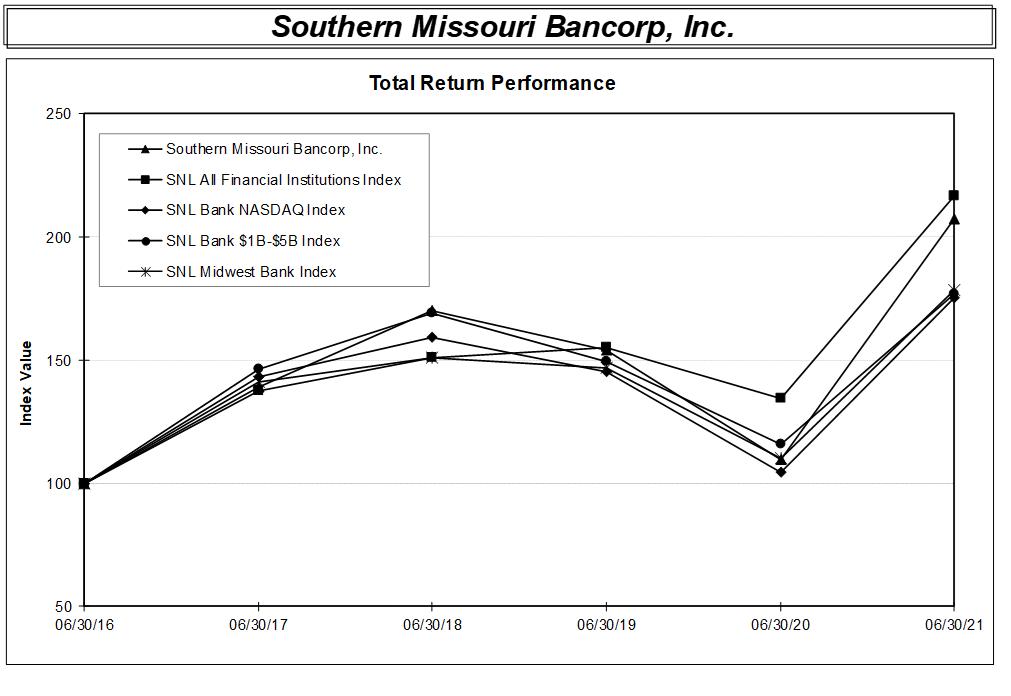The Company disclaims any obligation to update or revise any forward-looking statements based on the occurrence of future events, the receipt of new information, or otherwise.
Market Area
The Bank provides its customers with a full array of community banking services and conducts its business from its headquarters in Poplar Bluff, as well as 46 full service branch offices and two limited service branch offices, as of June 30, 2021. The branch offices are located in Poplar Bluff (4), Van Buren, Dexter (2), Kennett, Doniphan, Sikeston, Qulin, Matthews, Springfield (3), Thayer (2), West Plains, Alton, Clever, Forsyth, Fremont Hills, Kimberling City, Ozark, Nixa, Rogersville, Marshfield, Cape Girardeau (2), Jackson, Gideon, Chaffee, Benton, Advance, Bloomfield, Essex, and Rolla, Missouri; Jonesboro (2), Paragould, Batesville, Searcy, Bald Knob, Bradford, and Cabot, Arkansas; and Anna, Cairo, and Tamms, Illinois. In August 2021, a new branch was opened inWest Plains, Missouri.
For purposes of management and oversight of its operations, the Bank has organized its facilities into three regional markets. The Bank’s east region includes 24 of its facilities, one of which is limited service, which are situated in Butler, Cape Girardeau, Carter, New Madrid, Ripley, Scott, and Stoddard counties in Missouri, and Alexander and Union counties in Illinois. These counties have a total population of approximately 248,000, and included within this market area is the Cape Girardeau, Missouri, Metropolitan Statistical Area (MSA), which has a population of approximately 97,000. At June 30, 2021 the Bank’s south region includes 13 of its facilities, one of which is limited service, which are situated in Dunklin, Howell, and Oregon counties in Missouri, and Craighead, Greene, Independence, Lonoke, and White counties in Arkansas. These counties have a total population of approximately 425,000, and included within this market area is the Jonesboro, Arkansas, MSA, which has a population of approximately 136,000. The Cabot, Arkansas, branch in Lonoke County, is located in the northeast corner of the Little Rock, Arkansas, MSA. The Bank’s west region includes 12 of its facilities, which are situated in Christian, Greene, Phelps, Stone, Taney, and Webster counties in Missouri. These counties have a total population of approximately 554,000, and included within this market area is the Springfield, Missouri, MSA, which has a population of approximately 475,000. Each of these markets also serves a few communities just outside these county borders which do not have a notable impact on the demographics of the market area.
The Bank’s east and south regions are generally rural in nature with economies supported by manufacturing activity, agriculture (livestock, dairy, poultry, rice, timber, soybeans, wheat, melons, corn, and cotton), healthcare, and education. Large employers include hospitals, manufacturers, school districts, and colleges. In the west region, the Bank’s operations are generally more concentrated in the Springfield, Missouri, MSA, and major employers include healthcare providers, educational institutions, federal, local, and state government, retailers, transportation and distribution firms, and leisure, entertainment, and hospitality interests. For purposes of the Bank’s lending policy, the Bank’s primary lending area is considered to be the counties where the Bank has a branch facility, and any contiguous county.
Competition
The Bank faces strong competition in attracting deposits (its primary source of lendable funds) and originating loans. At June 30, 2021, the Bank was one of 26 bank or saving association groups located in its east region competing for approximately $6.6 billion in deposits at FDIC-insured institutions, one of 42 bank or saving association groups located in its south region (eight of these institutions overlap with the Bank’s east region) competing for $9.1 billion in deposits, and one of 45 bank or savings association groups located in its west region (13 of these overlap with the Bank’s east or south regions) competing for $15.1 billion in deposits.
Competitors for deposits include commercial banks, credit unions, digital payment applications, money market funds, and other investment alternatives, such as mutual funds, full service and discount broker-dealers, equity markets, brokerage accounts and government securities. The Bank’s competition for loans comes principally from other financial institutions, mortgage banking companies, mortgage brokers and life insurance companies. The Bank expects competition to continue to increase in the future as a result of legislative, regulatory and technological changes within the financial services industry. Technological advances, for example, have lowered barriers to market entry, allowed banks to expand their geographic reach by providing services over the Internet and made it possible for non-depository
